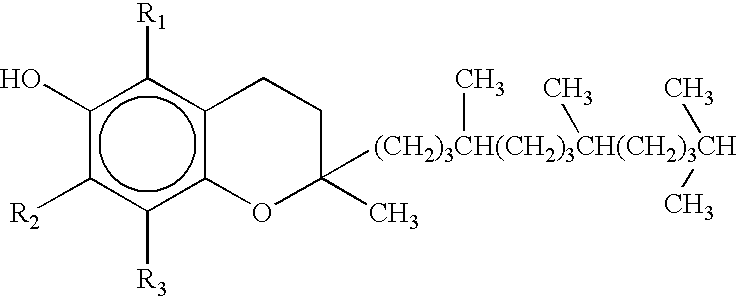Process for separation of tocopherols
- Summary
- Abstract
- Description
- Claims
- Application Information
AI Technical Summary
Benefits of technology
Problems solved by technology
Method used
Image
Examples
example 2
This example illustrates the effect of change in acetone concentration in elution of the product. 50 ml of FEED A was loaded on to the column by gravity flow as described in Example 1.
Tocopherols (%)AlphaBetaGammaDeltaYield (%)Raffinate0.00500 ml Heptane76.51.322.00.110.10250 ml 7% Acetone 93%0.00Heptane250 ml 7% Acetone 93%4.51.674.519.561.89Heptane250 ml 7% Acetone 93%1.70.637.660.112.72Heptane250 ml 7% Acetone 93%1.70.737.260.35.56Heptane500 ml 70% Acetone 30%11.31.319.967.54.72Heptane500 ml HeptaneCOLUMN REGENERATION
Hence by selective elution of the column we were able to isolate fractions with γ-tocopherol content of 74.5% with 61.89% yield.
example 3
This example illustrates the effect of change in acetone concentration from levels used in commercial applications in elution of the product. 50 ml of FEED A was loaded onto the column by gravity flow as described in Example 1.
Tocopherols (%)AlphaBetaGammaDeltaYield (%)Raffinate0.00500 ml Heptane76.10.419.44.18.12250 ml 3% Acetone 97%0.00Heptane250 ml 3% Acetone 97%14.82.379.43.538.23Heptane250 ml 3% Acetone 97%1.71.477.919.025.15Heptane250 ml 3% Acetone 97%0.10.340.559.117.20Heptane500 ml 70% Acetone1.70.215.283.010.3930% Heptane500 ml Heptane2.12.18.57.35.91
Hence, by selective elution of the column, we were able to isolate fractions with γ-tocopherol content of 79.4% with 38.23% yield.
example 4
This example illustrates the effect of change in acetone concentration in elution of the product. 50 ml of FEED A was loaded onto the column by gravity flow as described in Example 1.
Tocopherols (%)AlphaBetaGammaDeltaYield (%)Raffinate0.00500 ml Heptane98.60.11.00.34.72250 ml 1.5% Acetone0.0098.5% Heptane250 ml 1.5% Acetone0.0098.5% Heptane250 ml 1.5% Acetone1.31.786.910.131.3098.5% Heptane250 ml 1.5% Acetone2.10.335.662.032.9298.5% Heptane500 ml 70% Acetone0.20.317.682.020.3730% Heptane500 ml HeptaneCOLUMN REGENERATION
Hence, by selective elution of the column, we were able to isolate fractions with γ-tocopherol content of 87% with 31.30% yield. Specifically, lowering the acetone concentration produced unexpectedly good results.
PUM
| Property | Measurement | Unit |
|---|---|---|
| Fraction | aaaaa | aaaaa |
| Fraction | aaaaa | aaaaa |
| Fraction | aaaaa | aaaaa |
Abstract
Description
Claims
Application Information
 Login to View More
Login to View More - R&D
- Intellectual Property
- Life Sciences
- Materials
- Tech Scout
- Unparalleled Data Quality
- Higher Quality Content
- 60% Fewer Hallucinations
Browse by: Latest US Patents, China's latest patents, Technical Efficacy Thesaurus, Application Domain, Technology Topic, Popular Technical Reports.
© 2025 PatSnap. All rights reserved.Legal|Privacy policy|Modern Slavery Act Transparency Statement|Sitemap|About US| Contact US: help@patsnap.com

